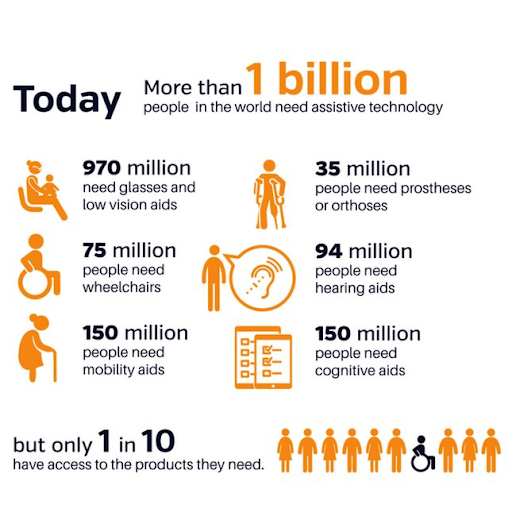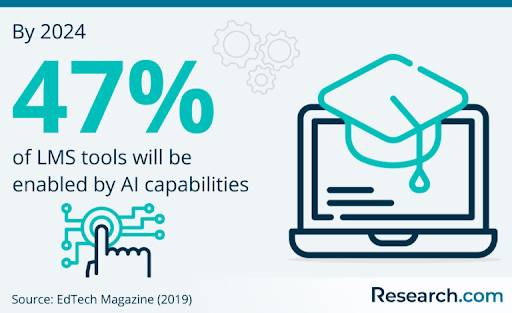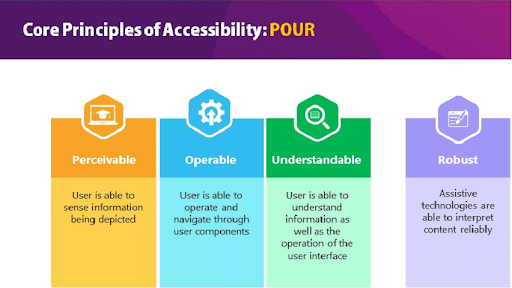Once upon a time, a company decided to launch an online course to help its employees grow. They put in a lot of effort to make sure the course was compliant with the latest learning accessibility standards.

For a while, the course seemed to be doing well. Most of the users had no problems understanding the content and could access it without any difficulty.
But then, as time went on, the company started to realize that the course was not fully accessible to all users.
Some users with disabilities found it hard to navigate, while others found the content too difficult to comprehend.
***
Online learning accessibility is an important topic that is often overlooked. E-learning platforms are (becoming) increasingly popular, with more and more organizations turning to online training as a viable alternative to traditional in-person learning.
However, many e-learning platforms and courses are not fully accessible to all users, particularly those with disabilities.
This can create barriers to learning and limit opportunities for individuals who rely on these platforms to improve their skills.
In this article, we will discuss the importance of elearning accessibility, the current status of accessibility, and best practices for improving it.

Simple Learning Accessibility Checks For Your Content
When it comes to making online learning accessible, there are a few simple checks that you can use to ensure your content is accessible to all.
The following simple online learning accessibility checks can help ensure that your online learning content is accessible to all:
Page Titles and Headings
Page titles and headings are important for both search engine optimization and elearning accessibility.
When using headings, make sure they are descriptive and concise and follow a logical hierarchy. This makes it easier for users to quickly navigate and scan the page.
ALT Text
ALT text (alternative text) is an important elearning accessibility tool that helps visually impaired users better understand images. When creating ALT text, use concise, clear language that accurately describes the image for users who can’t see it.
Color Contrast
When creating online learning content, make sure the colors used for the text and background provide sufficient contrast. This makes it easier for people with low vision to read the text.
Keyboard Access and Visual Focus Many people who are blind or with mobility impairments rely on the keyboard commands, such as voice input.
So, ensure that users can easily navigate your online learning content using only a keyboard or voice search.
Forms, Labels, and Errors
They should be clear, descriptive, and easy to understand. When users make errors, make sure that the error message is as descriptive and helpful as possible.
Moving, Flashing, or Blinking Content
Moving, flashing, or blinking content can be disorienting and distracting for some users. Especially some people with attention deficit disorder or visual processing disorders.
If you must use this type of content, make sure that users can easily turn it off or adjust the speed.
Multimedia Alternatives
When creating multimedia content for online learning, make sure to provide alternatives for those who are unable to access it. This includes providing transcripts for audio content and captions for video content. But more on that below.

Tips For Building A More Accessible And Inclusive Approach To Learning.
#1 Identify The Learning Accessibility Challenges
The first step in creating an online learning course is to tackle the accessibility challenges that may be present.
To do this, you should consult with experts in the field, such as web accessibility specialists, to get a better understanding of the requirements for accessible online learning.
Additionally, it is essential to do research on the existing elearning accessibility standards and guidelines to ensure that your course meets the criteria for accessibility.
However, the most important part is to consult with different members of your team to better understand THEIR challenges, as there are different areas you can focus your accessibility efforts.
After all, it’s about what they need and want and how to make their training more fun, interactive and inclusive.
#2 Accessibility And Inclusion Is A Journey, Not A Destination
To ensure the success of your online learning course, consider building learning accessibility and inclusion into your overall strategy.
It is NOT a one-time checkbox.
Creating an accessible and inclusive online learning course is not only good for those with disabilities, but it can also benefit all learners by providing more options to fit their needs.
Accessibility and inclusivity should be part of the entire design process, from conceptualization to implementation.
This includes considering factors such as content structure, usability features, visual elements, audio components, and multi-modal delivery methods.
#3 Make Your Learning Environment More Inclusive And Equitable
Creating an online learning course that is inclusive and equitable is essential for ensuring that everyone who interacts with it can benefit from it.
Accessibility constitutes an important part of this, as it ensures that all users, regardless of their physical or cognitive abilities, can access and interact with the content.
Unfortunately, online learning courses can often be designed with ability or disability in mind.
However, in order to make your learning environment more inclusive and equitable , you need to think of the full audience, as equity isn’t only about disability OR ability.
It’s about everyone who can benefit from the accessible and inclusive learning content.

#4 Think And Plan Ahead
Creating an online learning course is a great way to reach and educate a wide audience.
However, if you want to make your course truly successful and accessible to all, you must plan for online learning accessibility from the start.
It is not just a matter of making sure your content is readable and accessible to everyone. It also involves consideration of a range of learning styles, abilities, and technology limitations.
By asking your audience ahead of time or making materials available in advance, you can become aware of any potential obstacles that may limit the accessibility of your online course.
#5 Follow The Best Principles For Inclusive Course Design
Creating an online learning course that is accessible to all learners is an important goal for any organization.
Following the best principles and practices for inclusive course design will ensure that everyone has an equal chance to benefit from the educational material.
The first step in creating an accessible online learning course is understanding your organization’s needs, resources, and budget.
Knowing the expectations of the learners and the resources available to you will help you design a course that is accessible to all.
It is also important to consider the demographics of the learners and their preferred learning styles.

#6 Make Your Video Content Accessible Too
Video content is a powerful tool for online learning, but how accessible is it?
When creating your online learning course, it’s important to make sure your video content is accessible, too.
Accessibility to video content is important for students who are visually impaired or hearing-impaired, as well as those who have cognitive or physical disabilities.
It’s also important for those who are digital newcomers and those who prefer video-based instruction.
Making video content accessible requires considering a range of elements, including video captioning, audio descriptions, accessible video players, text readability, and color contrast.
Here’s a look at each of these elements and why they’re important for online learning accessibility.
#7 Check The Quality Of Your Course
When creating an online learning course, it is essential to check the quality of the course.
Quality assurance is essential to ensure the learners get a good learning experience.
Quality is one of the most important factors for a good online learning experience.
A good online learning course should be easy to use, provide high-quality content and be well organized.
It is also important that the course has an engaging tone and offers practical examples.
You can learn here how to check the quality during and after your elearning course creation.
#8 If You Can Measure It, You Can Improve It
Creating an online learning course can be a daunting task, especially if you don’t know where to start.
But, one key factor that can help you ensure the success of your course is to remember the old adage: “If you can measure it, you can improve it.”
To maximize the success of your online learning course, it’s important to take a long-term view and leverage effective management systems, data, and reporting tools to track progress and ensure continuous improvement in the most important areas.
Another important factor to consider when taking a long-term view is to focus on progress–not perfection.
You won’t want to spend too much time and energy on things that won’t have a real long-term impact on your course or that are not relevant to the skills your team is trying to hone.
Instead, focus on the elements of your course that can be improved over time, and that will have the most benefit for your learners.
With the right data and reporting tools, you can track progress and ensure continuous improvement in the most important areas. And by focusing on progress–not perfection, you can ensure that your course continues to be successful in the long term.
To Wrap Up
By taking a few simple steps, online learning courses can become more inclusive and equitable for all.
Taking the time to create an inclusive environment, ensure learning accessibility for everyone, and provide diversity in course materials will ultimately benefit everyone involved.
Inclusive online learning courses empower learners by providing them with the opportunity to learn from different perspectives and materials.
With this in mind, you can strive to ensure that your online learning courses are accessible to everyone and that each learner can reach their full potential!

